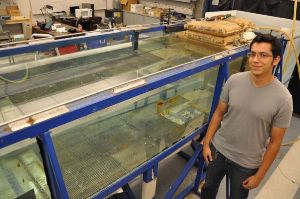Jul 22 2013
A University of California, Riverside student recently learned he will receive a $15,000 grant from an EPA national sustainable design competition for his idea to capture energy from ocean currents.
 Raul Delga Delgadillo stands in front of the flow tank he will use in his research.
Raul Delga Delgadillo stands in front of the flow tank he will use in his research.
Raul Delga Delgadillo, who will be a senior this fall at the Bourns College of Engineering, plans to spend the upcoming school year building a small-scale turbine and buoy system and testing it in a flow tank to determine the best way to maximize energy extraction. He expects the system will provide as much energy as an average wind turbine.
Delgadillo’s research comes shortly after the U.S. Department of Energy said wave and tidal energy, combined with other water-powered sources, could provide 15 percent of the United States’ electricity by 2030.
“The ocean remains an untapped frontier as a renewable energy source,” Delgadillo said. “I’m hoping to change that.”
Delgadillo, who grew up in Chula Vista, just south of San Diego, didn’t intend to go to college until he was encouraged to apply by friends during his senior year. At the time, he was living on his own, as his parents, who were divorced, had both moved to Texas for work.
He was accepted and enrolled at UC Riverside in 2010 and decided to major in mechanical engineering because he had always been interested in how things work and he wanted to make stuff.
The idea for the EPA P3: People, Prosperity and the Planet Student Design Competition for Sustainability entry came out of project for the Sustainable Product Design course taught by V. Sundararajan, an assistant professor of mechanical engineering.
Delgadillo’s project proposes several innovative designs: the buoy, which will allow the device to move around until an optimum location is found, and the telescoping feature on the turbine, which allows it to vary in height and remain stationary if waves are present.
Current proposals to harness energy from ocean currents require the turbine be anchored to the ocean floor using cables or rigid supports. This adds a significant cost, disrupts the environment because the ocean floor needs to excavated and limits the mobility of the turbine.
Delgadillo expects several challenges, including varying flow rates from ocean currents due to seasonal fluctuations; the fact that depth and contours of ocean floors can affect ocean currents; and avoiding harming marine life.
In the coming months, Delgadillo will perform experiments in a flow tank in the lab of Marco Princevac, an associate professor of mechanical engineering.
He will then use the data he gathers to write a proposal for a second round of funding, for $90,000, from the EPA. He will find out in spring 2014 whether he receives that money, which would allow him to take the design to a real world application.